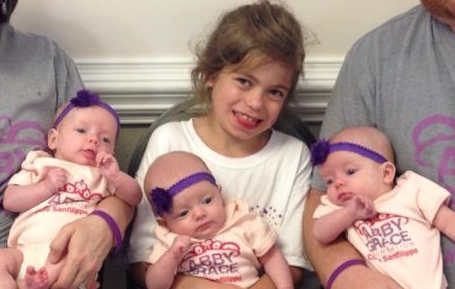One of the People in This Photo Is Not the Same -- Or Is She?
One of these is not the same. Can you tell which one?

They are all sweet little girls, happy, bright-eyed, full of love, full of hope and have a lifetime of memories to make. They are the same, right? Well, not exactly the same. They are all rare, and they are beautiful. As I reflect on Rare Disease Day, I keep thinking about what rare really means.
My 11-year-old daughter Abby has Sanfilippo Syndrome, a rare and fatal genetic disorder. The occurrence rate is 1 in 70,000 births. It is so rare that there are no approved treatments or a cure. A disease is considered rare if it affects fewer than 200,000 Americans at any time. The definition of “rare” is “not occurring very often, not found in large numbers, and consequently of interest or value.” That is my daughter exactly. She does not occur very often, she is not found in large numbers and she is of interest and value.
But in actuality, aren’t we all rare?
None of us occur often, are found in large numbers, and all of us are of interest and value. I admit I did not want Abby to be the rare child. I have wanted her to be the same as other children, have friends, playdates and sleepovers. I wanted her to tie her own shoes, ride a bike without training wheels and do her homework on her own. I wanted those things because it would mean she was not different and was well adjusted.
Over time, I have learned it is OK to be different and rare. Abby is a happy child and is well adjusted. It is OK that she is unable to tie her shoes or ride a bike on her own. She can do other things that are equally important to her. She can read, write, color, work a puzzle and dress herself.
We are all different, and we are all rare in our own way. We have our own characteristics, abilities, talents, desires and goals. I never really liked referring to my daughter as “rare” but have gotten more accustomed to the idea, especially when I understand that being rare can be truly beautiful. Aside from her having Sanfilippo Syndrome, she is a rare, beautiful flower. She is not defined by her disease. Her personality shines through, always silly, smiling and laughing. She shows concern for others’ feelings and wants to make sure others are included in activities around her. There is no one like her.
Those three precious little girls with Abby are identical triplets. They are her cousins and share the same family heritage, but they are like her; they are rare. Yes, the triplets are rare in the fact that the occurrence rate of being identical triplets is close to 1 in one million, even rarer than Sanfilippo Syndrome, but they are rare for many other reasons. They are rare because they are each their own person, have their own identity, personality and funny behaviors. They are different just like everyone else.
Being rare is truly not uncommon; it actually does occur often. We are all rare in our own way; we are not the same and we are all beautiful.
For more information about Abby and Sanfilippo Syndrome, please visit http://abbygracefoundation.org.
